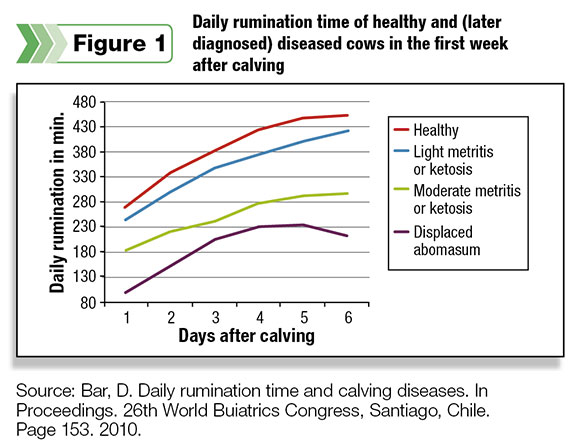The old adage “knowledge is power” certainly rings true when it comes to cow health. Entire management protocols and systems are designed around the quest to identify cows that are feeling subpar, perform needed interventions and quickly get them back on track.
Unfortunately, you can’t always see physical signs of illness. For example, visible signs of ketosis and other common metabolic disorders may not appear until much later than the actual onset of the disease, making the goal of early intervention a challenge.
“There aren’t a lot of people that can identify a cow when she’s just a little sick,” says Brent Moyer, manager of 1,200-cow Paramount Dairy in Caro, Michigan.
Early warning signs
To help with early interventions, dairy producers are turning to technology as a way to monitor a time-tested, reliable indication of cow health status: rumination.
According to research that followed cows from dry-off through 150 days in milk, rumination tends to decrease in the last two weeks before calving, drops suddenly at calving and then rapidly increases postpartum.
About a week after calving, cows usually reach normal daily rumination time, which stays relatively stable for the remainder of the lactation.
The average healthy cow ruminates around eight hours (or 450 to 500 minutes) every day. The rumination baseline for each cow remains relatively constant throughout lactation, meaning significant variations are a good indicator that a health event is taking place.
As a result, veterinarians and nutritionists have long used the practice of watching cud chewing to monitor health.
But few dairies have the time or resources to monitor rumination for every cow. Fortunately, newly developed technology allows producers and their management team to monitor rumination 24 hours a day, seven days a week.
This information alerts producers to any deviation from a cow’s “normal” rumination activity, enabling them to evaluate the individual cow for potential health issues.

Furthermore, the data can be used to target specific management areas for improvement.
Figure 1 shows the correlation of rumination time and disease incidence of several common metabolic disorders.
Aid in transition cow management
Since metabolic disorders often occur during the transition period, producers have found that rumination monitoring provides actionable data that can make a big difference in early diagnosis, resulting in improved cow health and performance that can impact the entire lactation.
“It was always a guess as to how the fresh cows were doing,” Karl Funk, co-owner of Funk’s Midway Dairy in New Munich, Minnesota, says of his dairy’s transition cow program prior to monitoring rumination data. “Most cows are healthy, but you’re always watching,” he adds.
Since integrating rumination monitoring into his family’s 600-cow dairy, Funk says the operation’s transition cow management has been streamlined – and more effective.
At 3 a.m. an employee goes over the rumination report to determine which cows need attention. “Instead of spending time watching all the cows, we go straight to those one or two cows that need attention,” says Funk.
Rumination data can also help identify cows with lower prepartum dry matter intake, which is important because cows with lower rumination time before calving also often have lower rumination time after calving – and suffer a greater frequency of disease than cows with higher rumination time in late gestation.
Moyer has noticed a correlation between the rumination activity of the pre-fresh cows and their post-fresh recovery. “If we see a dry cow that fluctuates in her rumination, about 75 percent of the time after she calves she has metabolic problems,” he says.
This knowledge enables the dairy to accurately predict which cows are going to have problems in the first two to three days after calving. “Rumination monitoring picks those cows out a few days before you would see it,” adds Moyer.
Bowman Dairy, a 1,000-cow dairy near Hagerstown, Indiana, has seen similar results. “We are now catching displaced abomasums 24 to 36 hours earlier, and we can see how they’re responding (to an intervention) in eight hours via the rumination data,” says co-owner Trent Bowman.
Assess response results
Bowman’s results indicate how monitoring rumination trends also enable dairy producers to assess a cow’s responses when an intervention has been made.
This information can be used by dairies to rate treatment protocols for effectiveness, as well as to indicate when adjustments may be necessary.
“We realized we were overtreating about half of our mastitis cases,” notes Funk. “Also, before the rumination monitoring system was in place, we would drench cows with ketosis twice a day for two weeks.
Now, in the second week, we usually drench only once a day and sometimes the system tells us they’re healthy enough to not need further treating.”
Bowman concurs. “We were doing a complete palpation and temperature monitoring protocol on all fresh cows, which used to take 1.5 to two hours per day. Now there’s no point checking the cow unless the rumination tells us she’s not eating properly. It all takes only about 30 minutes now.”
This knowledge has had a big impact on Paramount Dairy’s fresh cow protocol, too, making it faster and more effective than before rumination data was available to managers.
“We were going through a fresh-cow protocol every day, but now we do it every other day, so this has cut the time in half,” says Moyer.
“Once we treat, we check the graphs the next morning to see if a cow is coming up or going down. If rumination is going up, then we know the treatment is working – we don’t have to guess.”
After all, knowledge is power. PD
References omitted due to space but are available upon request. Click here to email an editor.

Shane St. Cyr
Field Support Manager
SCR Dairy Inc.






